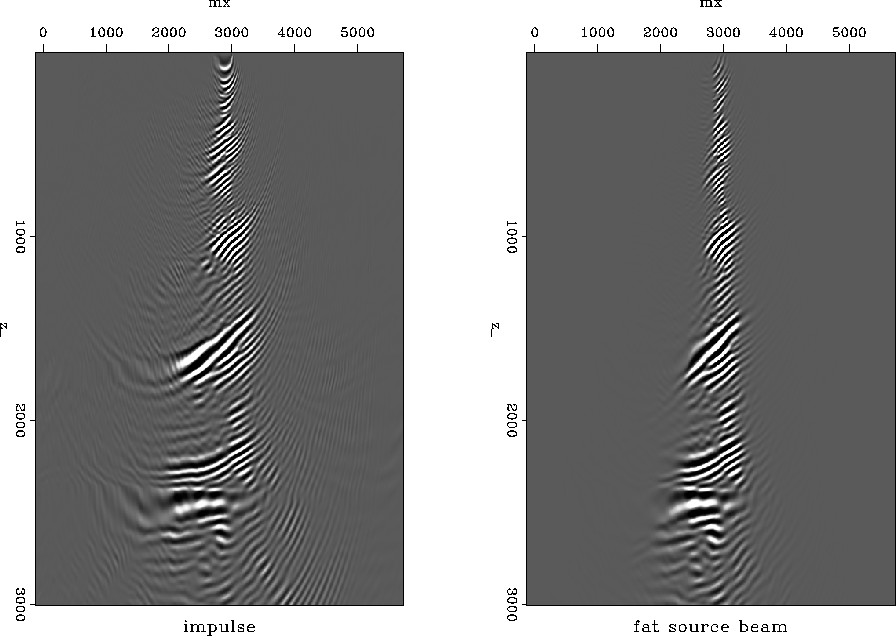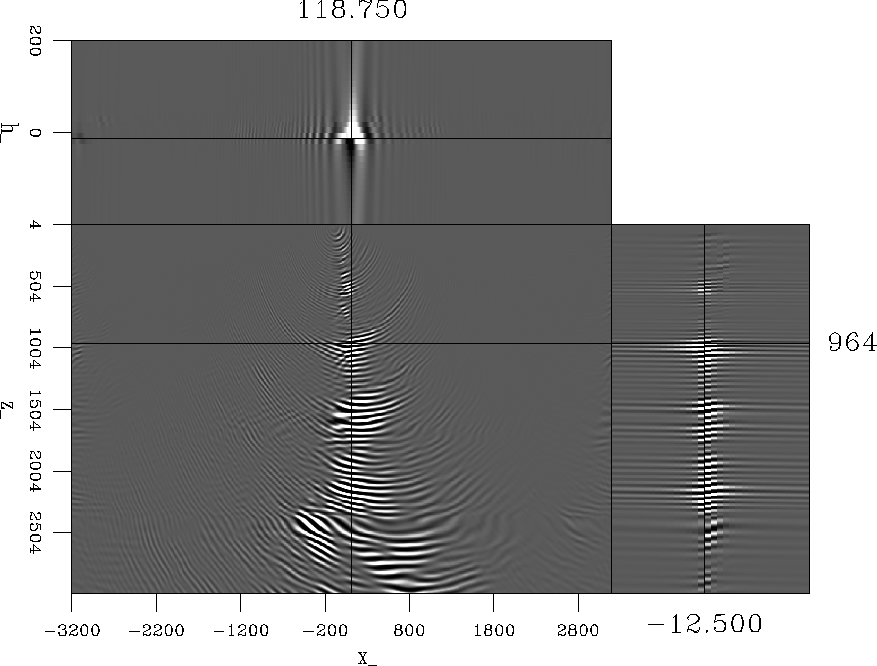




Next: Conclusions
Up: Artman et al.: Aliasing
Previous: Discussion
Despite the success in removing alias artifacts with the above two
methodologies, use of the bandlimited source function or the
bandlimited imaging condition in areas of complex geology has
one substantial limitation. Both strategies bandpass the wavefields
at some point during the migration which effectively introduces
focusing of the source illumination beam that propagates through the
model. This is due to elimination of kx energy in the
process. Figure 5 illustrates this effect using a shot
modeled over the Marmousi data set. The left panel shows an image generated
from the single shot with no restrictions imposed during migration.
The right panel however used the spatially bandpassed source
function. The introduction of low spatial frequencies into the
initial condition of the source wavefield effectively changes the
impulse into a short planewave. While this is appropriate to
limit aliasing when all the shots are summed, the focusing of the beam
directly down is inappropriate. To limit the dip-spectrum of
the geology appropriate to our sampling thereof, we have limited the
directionality of the source wavefield to near vertical as well.
marm
Figure 5 Left: Image from a single shot of
the Marmousi data conventionally migrated and with anti-aliasing
limits. The limited propagation angles are inappropriate. Center:
Full bandwidth shot image. Right: Dip-limited image via partial
convolution imaging condition.

Instead, our last methodology attempts to include all propagation
directions by choosing portions of the wavenumber spectrum of the
receiver wavefield that are appropriately limited for each component
of the source wavefield (or vice-versa). While the goal of the
imaging condition is a cross-correlation of the two wavefields
followed by extraction of the zero time-lag as shown in equation (4),
the process in effect multiplies across the space axis. Further, to calculate
offset, a spatial cross-correlation without summation is employed. The
Fourier dual of these two implicit operations are convolution and
multiplication respectively. Thus, by transforming our wavefields into
the wavenumber domain, the imaging condition takes the
form of the convolution

Inspecting the above, we notice that the counting subscript j is
actually the wavenumber offset axis with with the exponential inverse
Fourier transforming the axis during summation to give a single offset
panel. Thus, by not summing this dimension, we build the Fourier
transform of the offset axis.
Using this formulation, and the fact that kr - ks = kh, we can
bandlimit the image space by only allowing offset wavenumber
combinations where kr - ks is less than the prescribed bandlimit.
Thus, while calculating kx wavenumbers
for the image space, only a limited and varying band from
the offset axis is considered. In this manner, we can limit
reflectors to different offset spectra depending on their structural dip.
Figure (6) shows the result of this
implementation. Several features are prominent. First, the thick,
fast layer at (3000m, 2500m) contains dipping energy that is not in
the impulse response. This is a dip ringing due to implementing a
hard cutoff in the Fourier domain when selecting wavenumbers for
imaging. This noise should cancel during summation of many shots.
off-cube
Figure 6 Single shot image from
the band-limited convolutional imaging condition. The wave-number
bandwidth was limited to 1/8 of the receiver Nyquist limit.

Unfortunately, the convolutional imaging condition has Fourier domain
periodicity problems that are well avoided by operating in the space
domain. Further, there did not seem to be significant improvement
over illumination angle as compared to the two previous methods
proposed. Finally, given that our effective range of sub-surface
offset is actually quite limited, the huge cost differential, O(nx nh)
vs. O(nx2), makes the decision for us.





Next: Conclusions
Up: Artman et al.: Aliasing
Previous: Discussion
Stanford Exploration Project
5/23/2004

